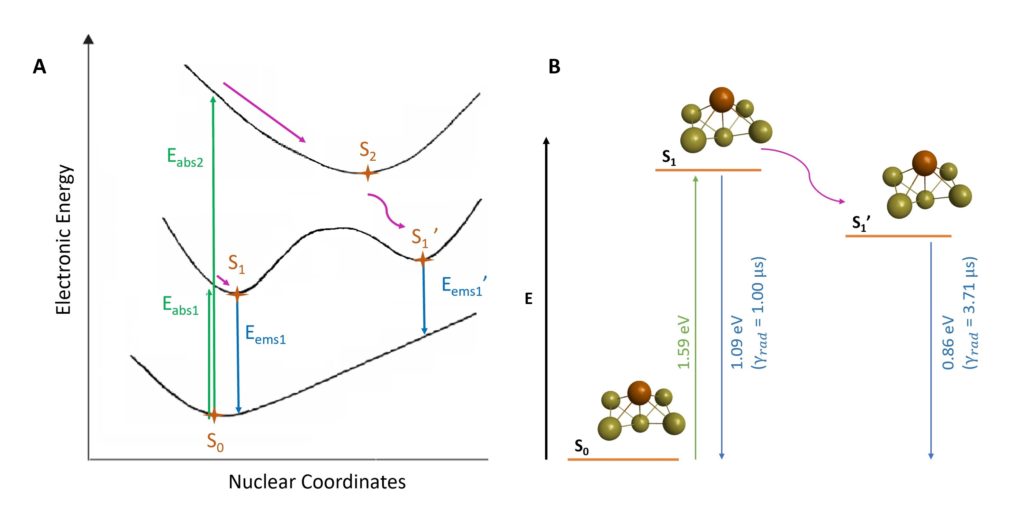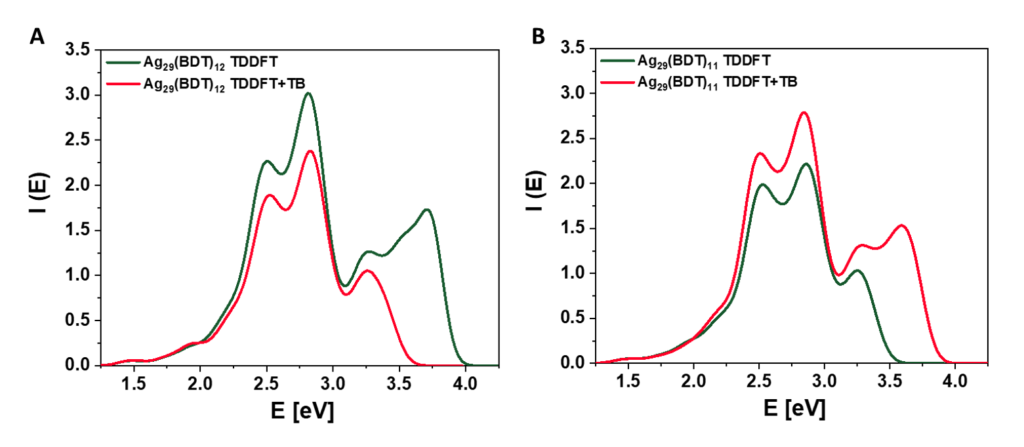Optical and photoluminescence properties of gold and silver nanoclusters
Silver and gold nanoclusters (NCs) have proven to be efficient and stable, with optical and emissive properties that can be tuned by changing the cluster’s geometric and electronic parameters. Due to the dependence of size, shape, surface ligands, charge state, etc., these NCs have extensive physical applications from bioimaging to catalysis. To this end, quantum chemistry methods such as DFT, TDDFT and TDDFT+TB provide a pathway to elucidate the origin of specific properties from a theoretical point of view.
In a recent paper the excited state potential energy surfaces of Au14Cd(S-Adm)12 were explored with TDDFT, uncovering the geometric and electronic origin of the electronic states responsible for the experimentally observed dual emission. Both emissive minima are established to be on the first electronically excited state, emitting 0.24 eV apart.

Ag29(BDT)12−x(DHLA)x NCs (x = 1−6, 12) provides a second example of emissive NCs, in which the optical properties change upon ligand substitution from BDT to DHLA. In addition to predicting the geometry of the fully substituted Ag29(DHLA)12, the authors found that while TDDFT calculations at the BP86/DZ level of theory underestimate the experimental emission, calculations with long range corrected functionals gave hints that the photoluminescence mechanism may primarily arise from metal-to-metal transitions.

In both projects, TDDFT+TB became an incredibly powerful tool to compute the optical properties of these nanoclusters, essentially replicating the spectrum obtained from TDDFT at a much lower computational cost. TDDFT+TB provided an easy way to additionally consider other levels of theory in order to best represent the experimental data.
All in all, these two recent papers outline a theoretical approach that can be applied to understanding the geometric and electronic differences that result from specific radiative interactions of nanoclusters with light.
See also: TD-DFT+TB keyword in ADF, TDDFT and approximate methods tutorial
[1] S. Havenridge, C. M. Aikens, Deciphering the Dual Emission in the Photoluminescence of Au14Cd(SR)12: A Theoretical Study using TDDFT and TDDFT+TB J. Chem. Phys. 155, 074302 (2021)
[2] Y. Zeng, S. Havenridge, M. Gharib, A. Baksi, K. L. D. M. Weerawardene, A. R. Ziefub, C. Strelow, C. Rehbock, A. Mews, S. Barcikowski, M. M. Kappes, W. K. Parak, C. M. Aikens, I. Chakraborty, Impact of Ligands on Structural and Optical Properties of Ag29 Nanoclusters, J. Am. Chem. Soc. 143, 9405–9414 (2021)